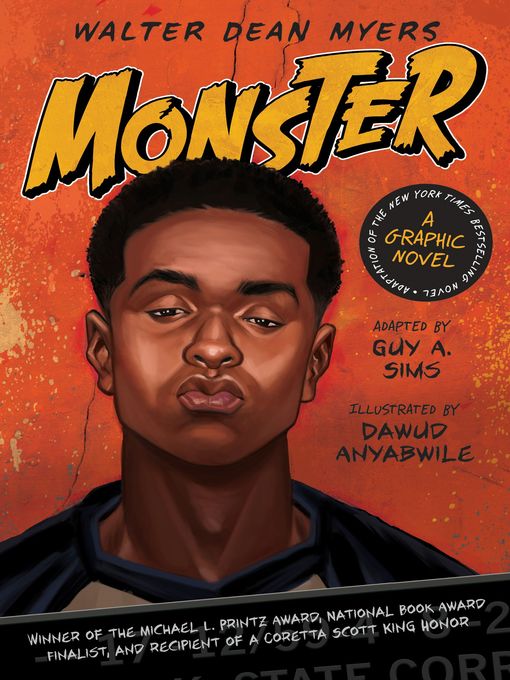
Monster
A Graphic Novel
فرمت کتاب
ebook
تاریخ انتشار
2015
Lexile Score
670
Reading Level
2-3
ATOS
3.6
Interest Level
9-12(UG)
نویسنده
Dawud Anyabwileناشر
HarperAlleyشابک
9780062275011
کتاب های مرتبط
- اطلاعات
- نقد و بررسی
- دیدگاه کاربران
نقد و بررسی

November 15, 2015
Mixed up in a heist that turned lethal, teenager Steve Harmon is on trial for murder and robbery. An amateur filmmaker, Steve imagines his ordeal as a movie starring himself as a "monster," since that's what those accused of the crime are labeled. Myers's portrayal of thorny moral issues as well as Steve's complicated emotions led to a number of awards for the novel on which Sims's graphic novel adaptation is based. Anyabwile's gray-scale drawings add layers to the drama. Older teens and adults; great for reluctant readers.
Copyright 2015 Library Journal, LLC Used with permission.

jaekid - I would say that this book is really amazing and I recommend it for other kids and this was a very good book about a kid who was in his late teens like 17 and he was involved in a gang and this man that worked at a corner store was killed and they took him and arrested him because they thought that he was guilty of killing him but at the end they caught the man who did it and he was able to go back home with his family but he went through a lot of problems and his mother was always crying because they took him away from her and his father was mad but sad because his son was locked up and he never did anything and his little brother was sad too. But he got out and he made a film about what happened and when he was back in school he showed it to the class and he lived a lot better after that and his family were together again.

May 14, 2001
. "Myers bends the novel form for this riveting courtroom drama that explores the guilt or innocence of a teenage boy involved in a murder," wrote PW
in a Best Books citation. Ages 12-up.

July 1, 1999
Gr 7 Up-Steve Harmon, 16, is accused of serving as a lookout for a robbery of a Harlem drugstore. The owner was shot and killed, and now Steve is in prison awaiting trial for murder. From there, he tells about his case and his incarceration. Many elements of this story are familiar, but Myers keeps it fresh and alive by telling it from an unusual perspective. Steve, an amateur filmmaker, recounts his experiences in the form of a movie screenplay. His striking scene-by-scene narrative of how his life has dramatically changed is riveting. Interspersed within the script are diary entries in which the teen vividly describes the nightmarish conditions of his confinement. Myers expertly presents the many facets of his protagonist's character and readers will find themselves feeling both sympathy and repugnance for him. Steve searches deep within his soul to prove to himself that he is not the "monster" the prosecutor presented him as to the jury. Ultimately, he reconnects with his humanity and regains a moral awareness that he had lost. Christopher Myers's superfluous black-and-white drawings are less successful. Their grainy, unfocused look complements the cinematic quality of the text, but they do little to enhance the story. Monster will challenge readers with difficult questions, to which there are no definitive answers. In some respects, the novel is reminiscent of Virginia Walter's Making Up Megaboy (DK Ink, 1998), another book enriched by its ambiguity. Like it, Monster lends itself well to classroom or group discussion. It's an emotionally charged story that readers will find compelling and disturbing.-Edward Sullivan, New York Public Library
Copyright 1999 School Library Journal, LLC Used with permission.

May 1, 1999
Gr. 9^-12. Myers combines an innovative format, complex moral issues, and an intriguingly sympathetic but flawed protagonist in this cautionary tale of a 16-year-old on trial for felony murder. Steve Harmon is accused of acting as lookout for a robbery that left a victim dead; if convicted, Steve could serve 25 years to life. Although it is clear that Steve did participate in the robbery, his level of involvement is questionable, leaving protagonist and reader to grapple with the question of his guilt. An amateur filmmaker, Steve tells his story in a combination of film script and journal. The "handwritten" font of the journal entries effectively uses boldface and different sizes of type to emphasize particular passages. The film script contains minimal jargon, explaining camera angles (CU, POV, etc.) when each term first appears. Myers' son Christopher provides the black-and-white photos, often cropped and digitally altered, that complement the text. Script and journal together create a fascinating portrait of a terrified young man wrestling with his conscience. The tense drama of the courtroom scenes will enthrall readers, but it is the thorny moral questions raised in Steve's journal that will endure in readers' memories. Although descriptions of the robbery and prison life are realistic and not overly graphic, the subject matter is more appropriate for high-school-age than younger readers. ((Reviewed May 1, 1999))(Reprinted with permission of Booklist, copyright 1999, American Library Association.)

























دیدگاه کاربران